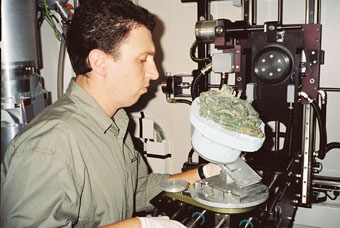A few days ago, the Archaeology Channel published a 14-minute video documentary about the Antikythera mechanism, featuring filmmaker Tony Freeth. It was originally posted on Nature's website in July, but if you haven't already seen it, it's well worth a look.
It's a beautifully made short film, and it includes footage of the project to image the Antikythera fragments in Athens in autumn 2005 (see pic). There are also some gorgeous X-ray images of details hidden inside the fragments, and a computer animation of the mechanism's internal workings.
This film was made to accompany the publication of Freeth's second Nature paper on the mechanism, which reported a preliminary reading of some of the inscriptions on its dials. This revealed that one of the dials kept track of the locations of the Panhellenic games, including the Olympic games, and that the device's calendar used local month names that may have come from Syracuse in Sicily. (There was also some new information about the eclipse prediction dial, but that's for another post.) You need a Nature subscription to read the paper itself but there's a lot of interesting data in the supplementary information, which is free.
Freeth and his colleagues, including Alexander Jones at the Institute for the Study of the Ancient World in New York, are now preparing a more extensive report on the inscriptions, though it'll probably be a while before this is ready. As well as providing clues to the Antikythera mechanism's place of origin, the researchers hope that the inscriptions can also be used to date it more precisely.
The ship on which the mechanism was found probably sank in the 60s BC, but what we don't know is how old the machine was when the ship went down. An epigrapher called Professor Benjamin Merritt who worked at the Institute for Advanced Study in Princeton studied its inscriptions in the 1970s, and concluded that they date from the first century BC, suggesting the mechanism was quite new when the ship sank. But Haralambos Kritzas, Director Emeritus of the Epigraphic Museum in Athens, recently dated them slightly earlier, around 150-100 BC.
Jones is looking for other inscriptions dating from around this time, to compare against the Antikythera inscriptions and hopefully pin down the date more tightly.

This pic shows Pandelis Feleris, a conservator at the National Archaeological Museum in Athens, getting the main fragment of the Antikythera mechanism ready for imaging by X-Tek's "BladeRunner" microfocus X-ray machine in November 2005 (thanks to X-Tek's Roger Hadland for the photo).